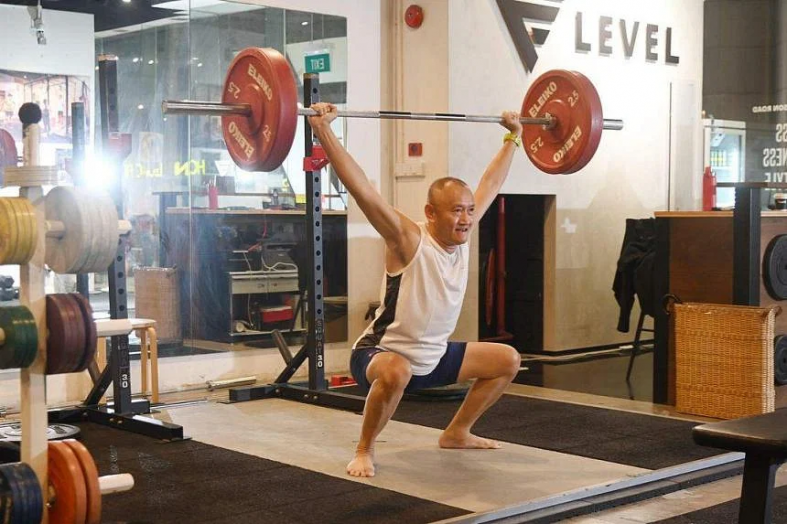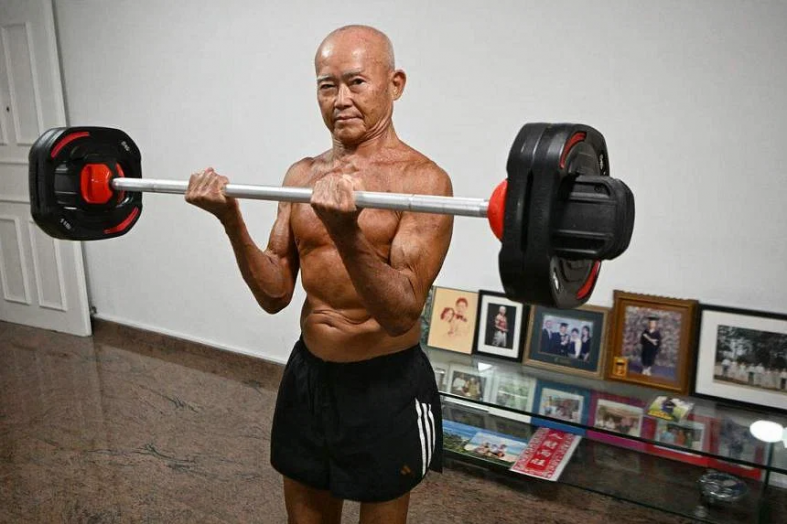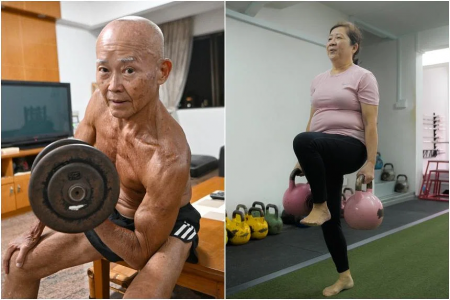Seniors who strength train: From struggling with a bag of groceries to deadlifting 50kg
Madam Samantha Thio used to struggle to carry a bag of groceries, but now she can deadlift 50kg.
In the past 20 years, the 67-year-old retiree has undergone multiple surgical operations, from inserting four stents into her heart to a cervical spine operation to repairing a broken meniscus in her left knee and a cracked right kneecap.
Madam Thio, who used to work as an assistant administrative officer in the oil and gas industry, led a sporty life in her 30s, but after the surgical operations, her fitness level dipped.
“When I bent to pick something up, my back used to hurt. I also couldn’t squat or kneel without feeling pain in my knees,” says Madam Thio, who is married and has a son, 44, and daughter, 35.
After retiring in 2018, she went for holidays, volunteered at church and spent time watching South Korean dramas.
But when she started limping out of the blue in 2020, her daughter suggested that she begin exercising and recommended a personal trainer at Strength Avenue gym in Boat Quay. Since then, she has been working out with a coach for an hour every week to improve her mobility and gain strength.
In the beginning, however, Madam Thio was afraid of getting injured.
“I had been fearful of climbing steps and falling due to my weak knees. So when I started personal training, I wondered if I could trust the coach to not hurt my joints. But after the second session, I found that this was working out because the coach took into account my slow pace,” she says.
Dr Shannon Chia, team lead at Sport Singapore’s Active Health division, says that between the ages of 30 and 60, there is a steady decline in muscle strength.
“Because the initial rate of decrease is ever so gradual, a person will not feel its significance until the age of 60 and above. Once past 60 years old, there is an accelerated loss of muscle strength. By the age of 80, this loss gets more significant,” she notes.
While muscle loss is a natural ageing process that cannot be undone, it can be slowed down through regular strength training, say experts.
Mr Abdul Muhaimin, who coaches Madam Thio at Strength Avenue, considered her age and medical history when working out a fitness plan for her.
“It took her six months just to gain confidence to lift any form of weight. She started off carrying an 8kg kettlebell before she moved on to the deadlift, and I progressively added weight over time,” says Mr Muhaimin. In a deadlift, one lifts a weight from ground to thigh-level.
“Sometimes, she may feel aches from the previous session, so I have to be careful to manage that as well,” he adds.

Dr Chia says a rule of thumb for anyone wanting to be more active is to start slowly and gradually build up intensity and duration, especially if it has been a long time since he or she last exercised.
“There are many ways to strengthen one’s muscles, whether at home or the gym, with each offering pros and cons. Seniors can consider using their body weight, resistance bands, free weights such as a dumbbell, or household items such as filled water bottles or used detergent bottles,” adds Dr Chia.
Apart from deadlifts, Madam Thio also does other strength-training exercises, such as squats with a medicine ball or dumbbells, and pushing a sled weighing 82.5kg in the gym. At home, she does simpler workouts such as hip hinges, squats and the glute bridge.
She bought a medicine ball, kettlebells and resistance bands to use in her home workouts.
For Madam Thio, strength training is “liberating”.
“When I first met my coach, he told me I hadn’t used my muscles in many years, so this process of trying to reawaken them would take time. Though it took me over a year to squat without pain, I was happy with my improvement,” she says.

Like Madam Thio, Mr Ng Siah Heng was sporty in his younger days, but started having difficulty squatting when he was approaching his mid-50s.
The 59-year-old adjunct lecturer at a tertiary institution took up a gym membership in 2020, when he realised he was not as strong and agile as before.
“I used to play badminton and tennis when I was young. But as I aged, my muscles felt stiff and my reflexes were slow. I had issues with balance, with a tendency to fall. I wanted to strengthen my body,” says Mr Ng, who is married.
He started by attending group fitness classes at Level Gym in Robinson Road. They were targeted at improving one’s cardiovascular endurance, agility and flexibility.
In 2021, he decided to engage a personal trainer at the gym for a more tailored fitness regimen. For an hour a week, Mr Ng mainly does a type of weightlifting called the snatch with his trainer.
The exercise, which can be done with a barbell, dumbbell or kettlebell, involves carrying a weight from the ground all the way overhead in one fluid motion. He started off with 20kg and can now lift up to 65kg. He aims to lift 80kg in 2023.
Says Mr Ng: “Since I started exercising and weightlifting, my balance has become a lot better and my reflexes are faster. When I walk on uneven ground, I feel more stable as my knees and thighs are stronger.”
Weight training gives him a “sense of euphoria”, he adds. “The blend of concentration, coordination and strength is something I truly enjoy while exercising.”
However, he is careful not to push himself too hard. “While it is good to improve the quality of life as we age, it is more important to have a good coach for guidance and know the limitations of your own body,” he says.
In selected ActiveSG gyms, Dr Chia says there are exercise machines suitable for seniors which are pneumatic and run purely on air pressure.
“These are machines that allow for smaller weight increments of 100g as opposed to traditional weight plates, providing a safer workout that is gentler on seniors’ muscles and joints,” she says.
Mr Victor Chan, a lifeguard and swimming instructor at the Singapore Armed Forces’ Basic Military Training Centre, started strength training at the age of 21.
But “carrying weights for successful ageing has been a different experience”, says the 70-year-old.
“As a youngster, I trained for a nice physique. But now, all I want is to feel strong and improve my mobility,” says Mr Chan, who is married and has a son and daughter.
He works out at home every day for about two hours, with dumbbells weighing 11kg to 13kg and a barbell of 20kg.
At his age, Mr Chan is careful not to overload himself with too much weight.
“When I was young, I had more strength. As I age, strength decreases, so it’s important that I listen to my body and ensure I don’t carry weights that are too heavy and instead train more for mobility. So I do more repetitions with lighter weights instead,” he adds.

Using equipment at home, Mr Chan does exercises such as the shoulder press, bicep curl and squat with dumbbells.
Besides strength training, he has also participated in many army half-marathons and triathlons, but stopped about four years ago after he underwent surgery to fix a nerve issue in his foot. He now takes it slow and runs 6km to 10km four to five times a week.
“I feel good when I exercise. I have more strength and energy, and don’t feel lethargic. It also improves my mood because I feel more lively,” he says.
Get The New Paper on your phone with the free TNP app. Download from the Apple App Store or Google Play Store now



